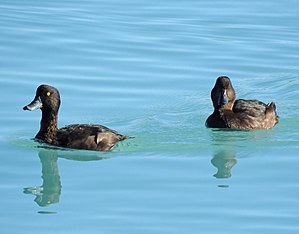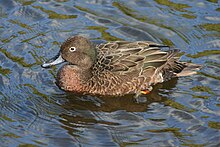Maori duck
| Maori duck | ||||||||||||
|---|---|---|---|---|---|---|---|---|---|---|---|---|

Maori duck ( Aythya novaeseelandia ) |
||||||||||||
| Systematics | ||||||||||||
|
||||||||||||
| Scientific name | ||||||||||||
| Aythya novaeseelandia | ||||||||||||
| ( Gmelin , 1789) |
The Maori duck ( Aythya novaeseelandia ), also known as the New Zealand diving duck , is a species from the diving duck group . It is a small diving duck that only occurs in New Zealand.
The IUCN classifies the Maori duck as not endangered ( least concern ). The population is estimated at 5,000 to 10,000 sexually mature individuals. The population has declined overall since New Zealand was settled; There are currently attempts to reintroduce the Maori ducks in some regions of New Zealand.
Appearance
The Maori duck reaches a body length of 40 centimeters, with about two thirds being the trunk. The wingspan is 60 centimeters, the wing length is 17.9 to 19.6 centimeters in the males, 17.8 to 18.9 centimeters in the females. Males weigh an average of 700 grams, females 600 grams. Maori ducks are among those duck birds that do not show pronounced sexual dimorphism . Both sexes have black-brown plumage. The iris of the drake is yellow and the bill is light blue with a black nail. In the duck, on the other hand, the iris is olive brown and the plumage on the underside of the body is slightly lighter. Some of the females have a white spot at the base of their beak, but this is only noticeable in around fifty percent of the females in captive animals. There is no discernible difference between a gorgeous and a simple dress .
The chick's downy dress is sepia brown on top and lightens to a brownish gray on the neck and face. Both the beak, the iris and the feet are dark gray in color, while the webbed feet are black.
The Maori duck is a skilled diver and reaches diving depths of two to three meters. When diving, she only uses her feet to maneuver underwater, the wings are not used. Basically, Maori ducks only fly at low altitudes.
Possible confusion


In principle, the Maori duck cannot be confused with any other species of duck due to its small size and shape. The very rare New Zealand duck shows a similarity, but differs from the Maori duck, among other things, by a white eye ring. The Australian bog duck is rare in New Zealand. It differs from the Maori duck in that it has a flatter forehead, more brownish plumage, a white under-tail cover and a black beak. The males of the Australian bog duck also have almost white eyes.
Distribution area and existence
The Maori duck is native to New Zealand and was a common bird there until the turn of the 20th century. Due to heavy hunting pressure and the transformation of the lowlands into agricultural areas, their number decreased so quickly that they were removed from the list of huntable birds in New Zealand as early as 1934.
Their population is estimated today at less than 10,000 adult birds. Resettlement attempts in the southeastern part of the North Island of New Zealand were successful. Today there are some smaller populations again that are stable.
Habitat and food
Maori ducks prefer to live near clear, deep lakes in the mountain and grazing regions of New Zealand. They occur there up to a height of 1000 m . They can also be seen very rarely in protected estuaries. Basically, they prefer large bodies of water and usually stay at some distance from the shoreline. The Maori duck is absent from lagoons and lakes with brackish water in coastal areas and occurs only very rarely on currents. During the winter months, sometimes very large groups gather on bodies of water that offer this species a suitable habitat. Troops of non-breeding Maori ducks can be seen year round. The individual individuals in a squad show little antagonistic behavior to one another. The troops are often socialized with eyebrow ducks and other water birds.
Like many other diving ducks, they prefer to eat small mollusks . Plants also play a role in their diet. It finds its food by diving or ingesting insects from the surface of the water.
Reproduction
The reproductive biology of the Maori duck has not yet been conclusively investigated. It is considered monogamous, but it is not known whether the couple relationship lasts for a reproductive period.
The courtship season for this duck is September and October. The breeding season begins in late October and November. The ducks build their nests in the reed or on damp meadows near the water. Occasionally loose breeding colonies form. Occasionally, nests are found closer to one another; there is a documented report of four Maori duck nests on an area of 20 square meters. In another location, three nests were found over an area of ten square meters. The clutch consists of four to eight cream-colored eggs. The female breeds alone, the drakes stay near the breeding ducks during the breeding season. Single males swimming on the water near the shore are usually an indicator of a female breeding on the shore line.
Brooding females sit very firmly on their clutches and sometimes only fly up when a person has approached more than two or three meters. Others continue to sit still or even become aggressive. Aggressive reactions are more common when the chicks are about to hatch.
The chicks hatch after 28 to 30 days. They weigh around 40 grams when they hatch. The chicks usually leave the nest 12 to 24 hours after hatching. Only the female is involved in leading the chicks. If a bird of prey approaches, the female parent bird warns with calls, the young then dive. It has also been observed that the female parent bird then flies up in the direction of the bird of prey. If potential predators approach when the female parent bird is together with the young near the bank, the young birds swim towards the middle of the lake after the female calls out the alarm, while the female tries to mislead the predator . Occasionally, several females form larger groups with their offspring. The young birds in a clutch usually do not mix. In principle, these troops are no longer in existence. The young birds are fledged at an age of around ten weeks and are led by the female parent bird up to this point.
Maori ducks held in captivity have already hatched in their first year of life, but it is not known at what age Maori ducks first hatched in the wild.
Man and maori duck
The Maori duck breeds very well in captivity and birds raised in human care are easy to release into the wild. This behavior is used to reintroduce the Maori ducks in regions where they are now missing. The species is now fully protected in New Zealand.
In Europe, the Maori duck is relatively rare as an ornamental fowl . Maori ducks were introduced to the UK by the Wildfowl and Wetlands Trust in 1956 and 1957 and were first bred in Slimbridge in 1958. The European enclosure population that was built up afterwards is likely to go back exclusively to these animals. The Maori ducks were first bred in the United States in 1962 and in 1966 at Tierpark Berlin. Since the 1980s, the reproduction rates of the European enclosure population have declined, which is interpreted as an indication of the onset of inbreeding depression . Since the mid-1990s, the Maori duck has only been kept sporadically in Western Europe.
supporting documents
literature
- T. Bartlett, Ducks And Geese - A Guide To Management , The Crowood Press, 2002, ISBN 1-85223-650-7 .
- PJ Higgins (Ed.): Handbook of Australian, New Zealand & Antarctic Birds , Volume 1, Ratites to Ducks, Oxford University Press, Oxford 1990, ISBN 0195530683
- Hartmut Kolbe; Die Entenvögel der Welt , Ulmer Verlag 1999, ISBN 3-8001-7442-1 .
Web links
Single receipts
- ↑ BirdLife Factsheet on Maori Duck , accessed April 22, 2011
- ↑ Kolbe, p. 282
- ^ Higgins, p. 1359
- ^ Higgins, p. 1358
- ^ Higgins, p. 1358
- ^ Higgins, p. 1360
- ^ Higgins, p. 1359
- ^ Higgins, p. 1359
- ^ Higgins, p. 1359
- ^ Higgins, p. 1360
- ^ Higgins, p. 1360
- ^ Higgins, p. 1360
- ^ Higgins, p. 1360
- ^ Higgins, p. 1361
- ^ Higgins, 1361
- ^ Higgins, p. 1359
- ↑ Kolbe, p. 283
- ↑ Kolbe, p. 284

